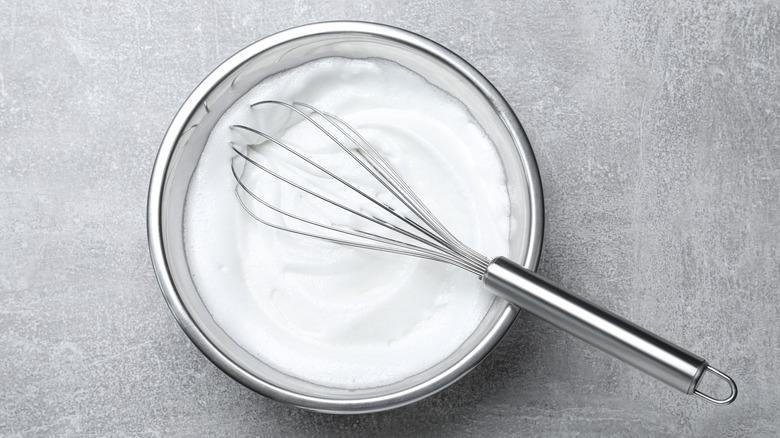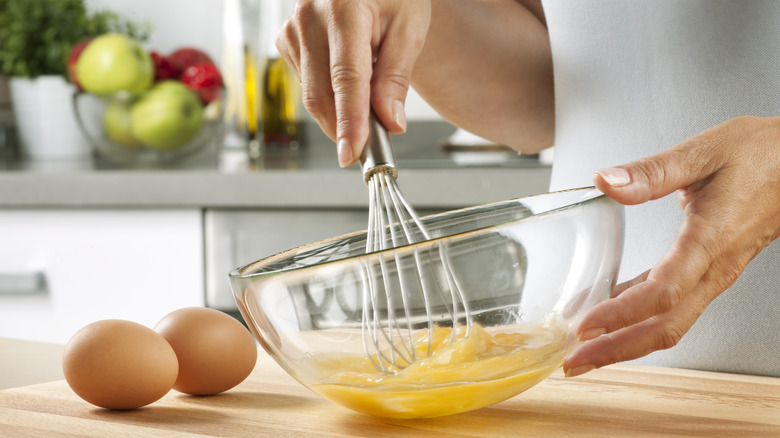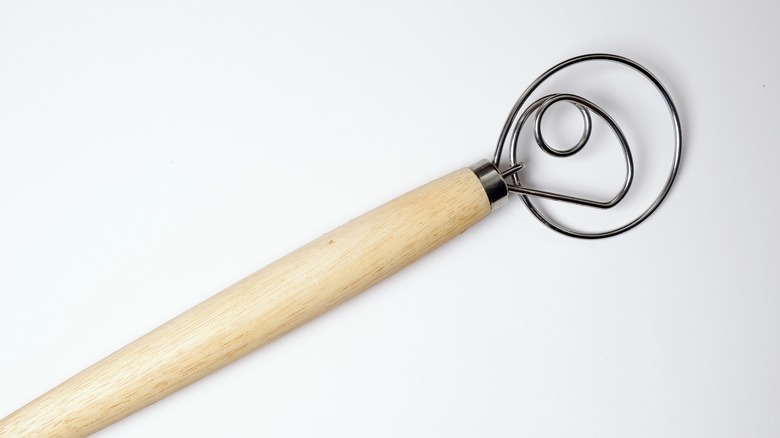The Key Difference Between A Balloon And French Whisk
Buying a whisk seems pretty straightforward, but if you head to a well-stocked cookware store (or even just a supermarket), you might notice that these tools come in all sorts of shapes and sizes. Some are bigger, others smaller; some are rather simple, with ball-tipped metal wires jutting straight out of the handle while others come in uniquely twisty shapes. These differences aren't just for show — every type of whisk has a specific purpose, and even the smallest differences can greatly impact your recipes.
Balloon and French whisks, two of the most popular types, look very similar to each other. Both possess flexible, looped wires at the head in a sort of hot air balloon shape, and either can make quick work of whipping air into eggs, dairy, cake batter, and more. However, the balloon whisk has a wider head and slightly thinner wires, making it more ideal for delicate foods like meringue, egg whites, and ultra-flavorful whipped cream.
Conversely, the French whisk is more narrow with thicker wires, which makes it perfect for mixing heavier foods like batter, sauces, and custard. Due to its narrower shape, this whisk is also great for smaller pots and bowls but can prove challenging to clean.
The uses (and misuses) of balloon and French whisks
As similar in appearance as the balloon and French whisks might be, their designs lend to very different strengths and weaknesses. The balloon whisk, for instance, is generally considered a jack of all trades, but its wider loops may struggle with precise mixing or getting into corners. This whisk may not even give your recipes the aeration you desire, as it possesses only a single layer of loops. It's safe to say that the balloon whisk's name came from its design, and not from its ability to effortlessly aerate whipped desserts. However, if you need to make a dense batter, the balloon whisk is your best bet.
The French whisk, on the other hand, has a sleeker design that excels in narrow spaces. Because its loops are closer together, the French whisk can easily aerate and emulsify thinner liquids — like a tangy salad dressing made from overripe fruit. Of course, having more compact loops means the French whisk can quickly be overpowered by thicker, clumpier recipes. Thick batters, for example, will clog this whisk and render it as useful as a baseball bat in your whisking endeavors. The French whisk is also rather inefficient in mixing large quantities, given its narrow shape, so save this utensil for smaller, lighter projects.
Do you really need one of each whisk type?
Although the balloon whisk is the very picture of a multipurpose tool, other types of whisks are designed for incredibly specific tasks. For example, the dough whisk features a flat coil of wires forming three loops and is intended for mixing dough and thick batters, cutting through with more efficiency than a spoon might. Its sturdy design also aids in incorporating and evenly dispersing dry ingredients. Sounds perfect for sprucing up banana bread with dried fruit, right? Another incredibly specialized whisk is the spiral whisk, which resembles a small Slinky on a wire loop, positioned at an angle on the end of the handle. The spiral whisk easily reaches the bottom of pots and pans, unsticking clumps and keeping your ingredients from burning.
However, this isn't to say you need one of each whisk type in your kitchen. Instead, you should — at the very least — own a balloon or French whisk, as these two types are extremely versatile. You can then add another whisk, if necessary, depending on the recipes you make most often. For instance, if you make a lot of bread or thicker dough, you would benefit from owning a dough whisk. If you're a big fan of homemade breakfast, you might buy a mini whisk to scramble eggs with ease. If you like whipping up your own vinaigrettes and salad dressings, it might be useful to have a spiral whisk on hand.



